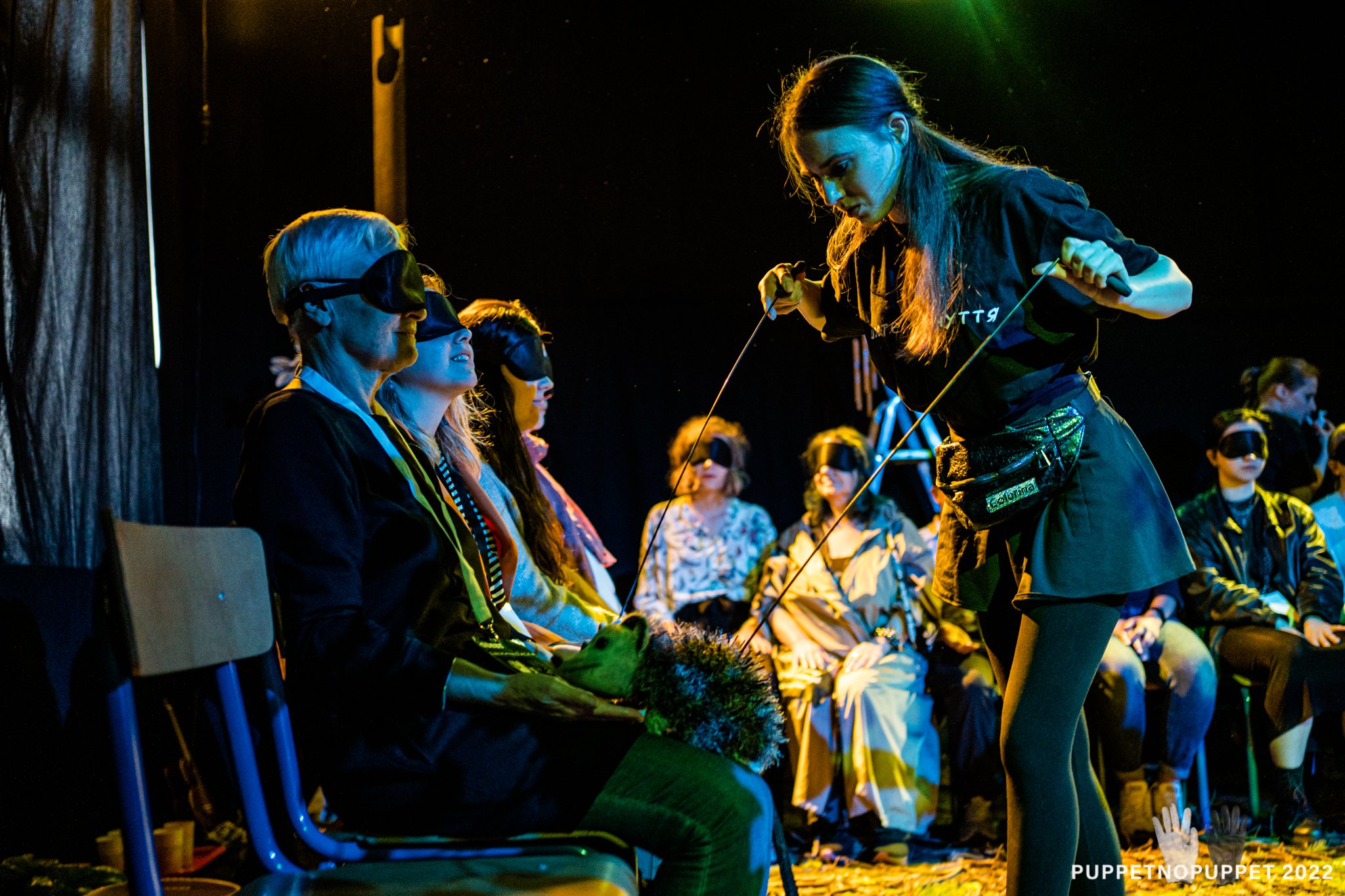the stage as a forest
critical review of What grows in the park (Kto rośnie w parku) by students from Kyiv National Ivan Karpovich Karpenko-Kary Theatre, Cinema and Television University (Ukraine). work presented during the 10th International Festival of Puppetry Schools PUPPETNOPUPPET (LALKANIELALKA) in Bialystok, Poland, on June 2022. this text is written by amilton de azevedo within the context of the Puppet Theater Criticism Workshop offered by the International Association of Theater Critics (IATC).
As the spectators gathered around the presentation room for “What grows in the park” (“Kto rośnie w parku”), the PUPPETNOPUPPET Festival volunteer announced that there would be only place for a few people: around fourteen could take a part on the immersive proposition by the ukrainian students from Kyiv National Ivan Karpovich Karpenko-Kary Theatre, Cinema and Television University; sixteen more would be allowed to watch. Expectants and spectators.
The distinction is important when considering the nature of the work. For those actively participating, it would not at all be about seeing anything – they were blindfolded and guided inside the room by the performers and, once inside, would have all their other senses provoked by the performers. The others would sit in a small audience space and be observers of the work. On the presentation of the 21st of June, I was one of those voyeurs of the actions that took place in an Akademia Teatralna room.
With my eyes opened, I could not only see the performance itself but actually the means of sustaining the sense-provocation act. For about fifty minutes, the participants would be engaged in diverse ways, with the performers teasing their hearing, tasting, smelling and touching – by depriving them of their vision, their imagination was actively evoked; asides from the forest thematic and the brief synopsis, they did not quite knew what to expect and how to react. “What grows in the park” is an invitation for other forms of a performing arts possibility of fruition beyond seeing.
The collective of young ukrainian girls told a tale about the journey of oneself trying to discover not only who they are, but finding themselves as a being in a communal manner, regarding both their appearance and cultural traits, which appears to be symbolized here by the meaning of each plant’s name. It is the quest of a recently-emerged sprout in the direction of their ancestry and identity.
Structured as an immersive experience, “What grows in the park” actually starts before the room door is closed: the relationship between performers and participants is established outside, once the rules are announced, each one of the performers who would guide each participant would introduce themselves before distributing the masks. Inside, the participants are sat down on chairs around a forest-inspired set – leaves and branches are on the floor and the sound landscape is created by bird whistles played by the performers.
As they are sat there to engage themselves and their senses in the performance, the observers are allowed within the room. The experience is meant for the blindfolded participants, as all of the actions were done (for most of the parts, literally) on them, but sitting in the corner was a possibility to see not only what was organized and proposed by the artists but also the reception and reaction of the individuals receiving their multiple stimulus.
Birds flying and singing, leaves flowing with the wind, puppet animals stepping onto feets and legs, climbing on shoulders and running through necks and heads: as the performers would interact with the participants, one – as an observer – could notice how they materialized the sense-teasing and fiction-building efforts. From the umbrella-shaking rustle of wings to the liquid on the syringe mimicking tree nectar, it was with eyes wide open that it was possible to realize how an artwork can see the stage as a forest – and, at the same time, transporting those immersed to that (distant) nature through not only soundscaping, but essentially sensescaping.
Alongside the sprout’s process of searching for themself, “What grows in the park” brings within the immersive proposal the collective context: it is impossible to separate from reception the situation of Ukraine. The audience, whilst taking part in this metaphorical coming of age narrative, seem to be also participating in the student-artists group’s own particular journey of self-discovery and sharing and their culture, especially through beautifully sung music.
Uniqueness, as claimed by the dramaturgy, is not a particular trait – here, identity appears to be only comprehensible through community and belonging. As if one can be themself only where there is recognition, which can come from nature, history or culture; seeing, hearing, smelling, feeling, tasting, and perhaps even a sixth sense. Intuition, faith, imagination: probably only that one living being that is growing in a park can answer – to himself and their owns – what is growing in the park.
[be a supporter of amilton de azevedo’s critical production: meet the continuous crowdfunding campaign keeping the ruin alight!]

